Exercise as an Alternative Treatment for Mental Health Nursing
VerifiedAdded on 2023/06/18
|14
|5405
|142
AI Summary
This article explores the use of exercise as an alternative treatment for people suffering from mild to moderate depression. It covers the impact of behavioural activation with physical activity promotion, guided physical activity, web-based exercise intervention, cognitive behavioural therapy with physical activity, and running therapy. The article also discusses the efficacy and acceptability of exercise interventions and their benefits compared to antidepressants and psychological therapies.
Contribute Materials
Your contribution can guide someone’s learning journey. Share your
documents today.
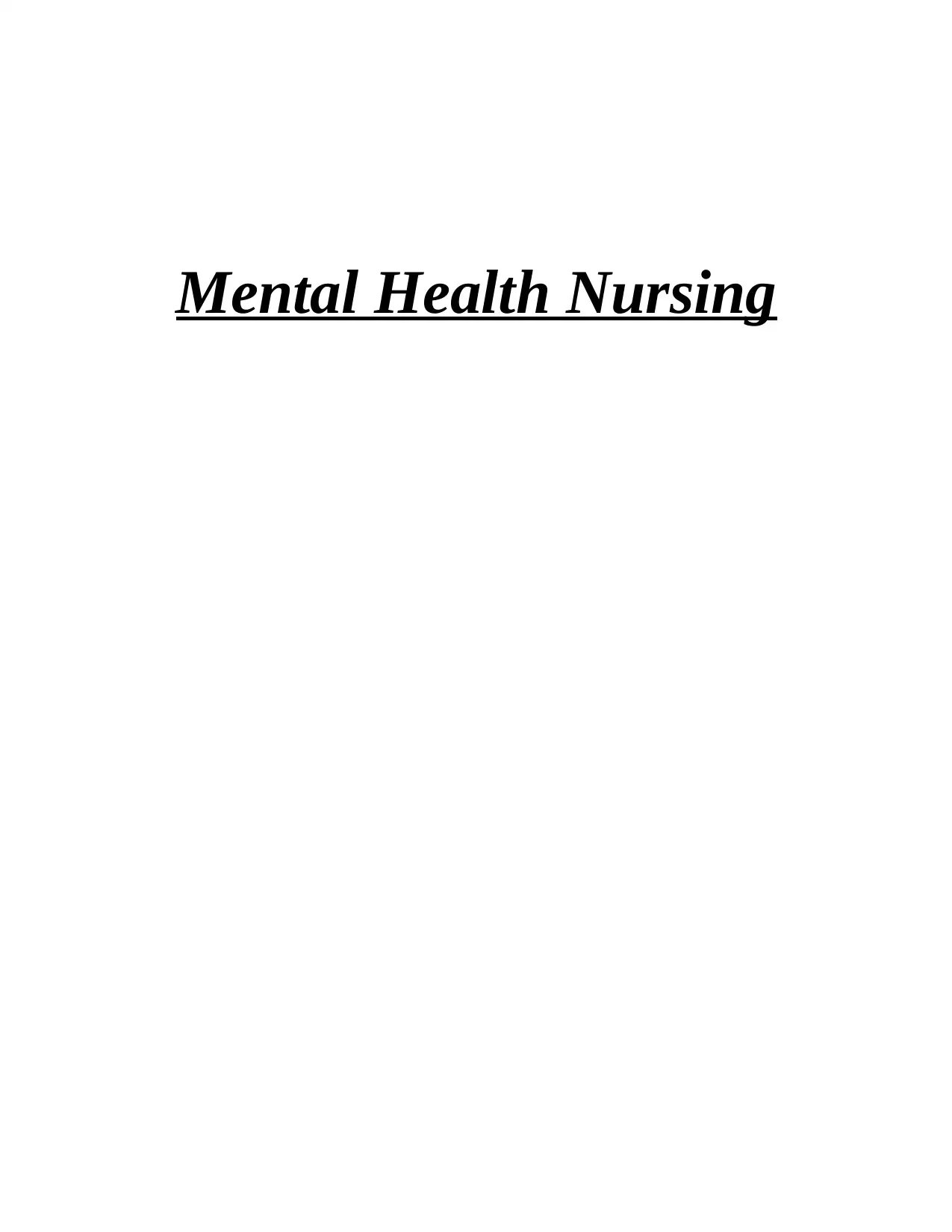
Mental Health Nursing
Secure Best Marks with AI Grader
Need help grading? Try our AI Grader for instant feedback on your assignments.
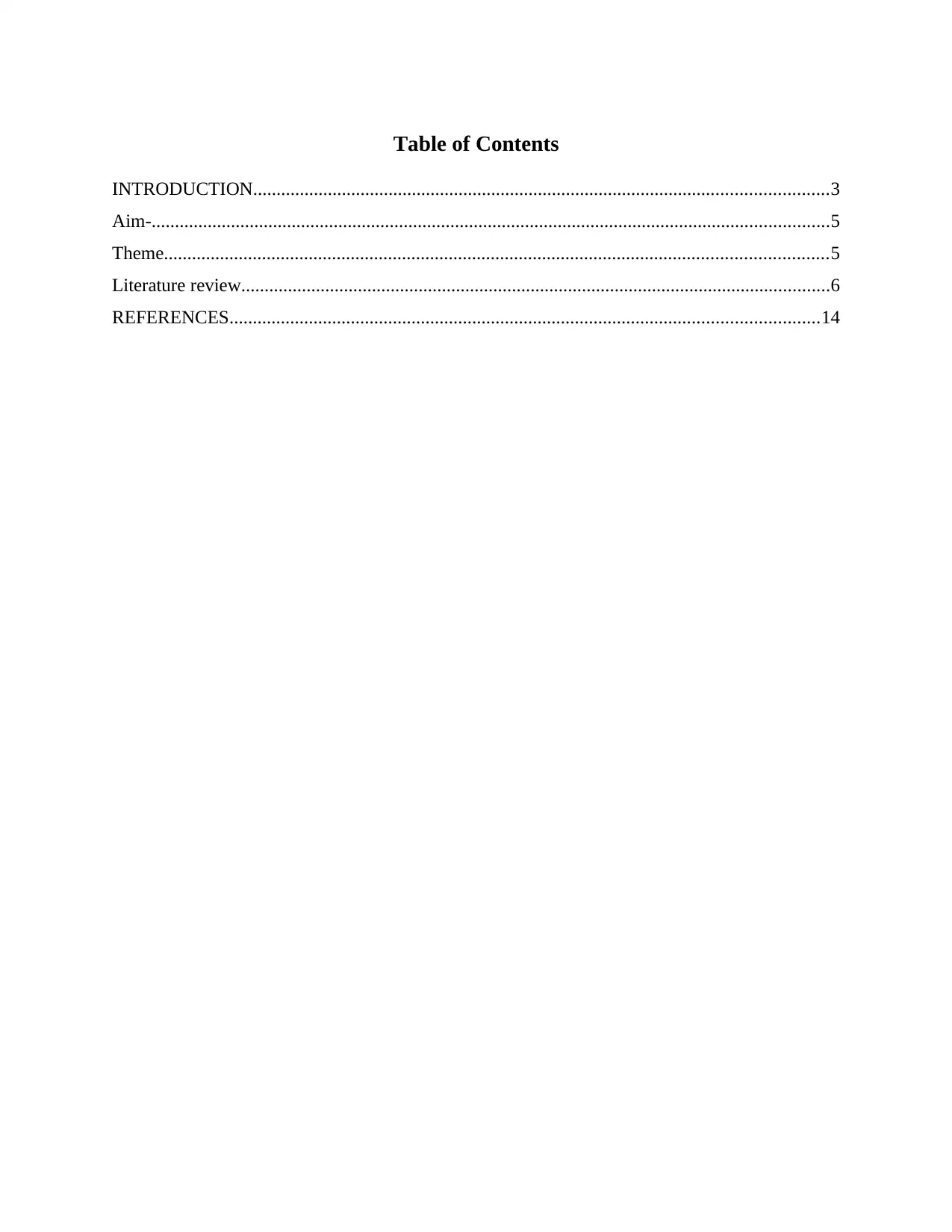
Table of Contents
INTRODUCTION...........................................................................................................................3
Aim-.................................................................................................................................................5
Theme..............................................................................................................................................5
Literature review..............................................................................................................................6
REFERENCES..............................................................................................................................14
INTRODUCTION...........................................................................................................................3
Aim-.................................................................................................................................................5
Theme..............................................................................................................................................5
Literature review..............................................................................................................................6
REFERENCES..............................................................................................................................14
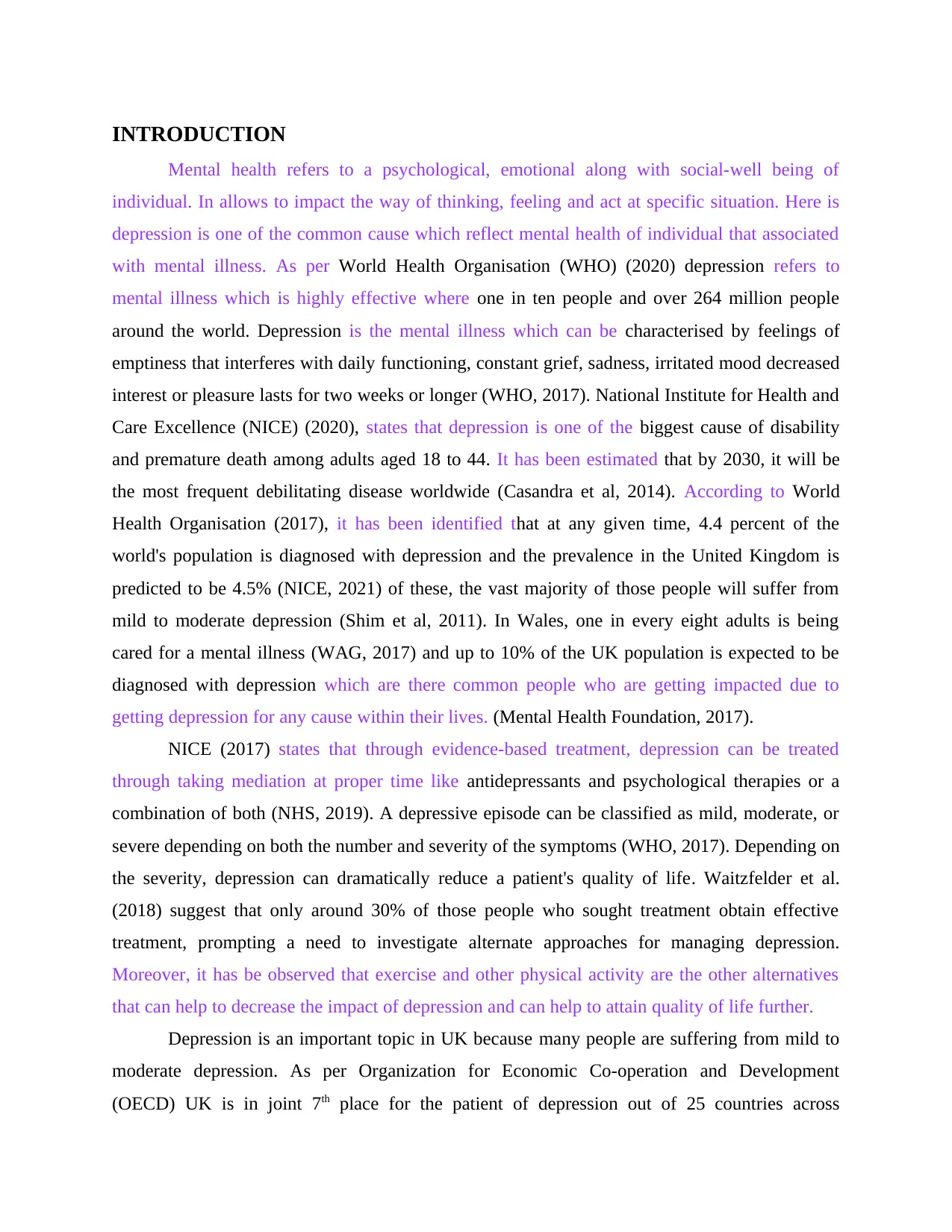
INTRODUCTION
Mental health refers to a psychological, emotional along with social-well being of
individual. In allows to impact the way of thinking, feeling and act at specific situation. Here is
depression is one of the common cause which reflect mental health of individual that associated
with mental illness. As per World Health Organisation (WHO) (2020) depression refers to
mental illness which is highly effective where one in ten people and over 264 million people
around the world. Depression is the mental illness which can be characterised by feelings of
emptiness that interferes with daily functioning, constant grief, sadness, irritated mood decreased
interest or pleasure lasts for two weeks or longer (WHO, 2017). National Institute for Health and
Care Excellence (NICE) (2020), states that depression is one of the biggest cause of disability
and premature death among adults aged 18 to 44. It has been estimated that by 2030, it will be
the most frequent debilitating disease worldwide (Casandra et al, 2014). According to World
Health Organisation (2017), it has been identified that at any given time, 4.4 percent of the
world's population is diagnosed with depression and the prevalence in the United Kingdom is
predicted to be 4.5% (NICE, 2021) of these, the vast majority of those people will suffer from
mild to moderate depression (Shim et al, 2011). In Wales, one in every eight adults is being
cared for a mental illness (WAG, 2017) and up to 10% of the UK population is expected to be
diagnosed with depression which are there common people who are getting impacted due to
getting depression for any cause within their lives. (Mental Health Foundation, 2017).
NICE (2017) states that through evidence-based treatment, depression can be treated
through taking mediation at proper time like antidepressants and psychological therapies or a
combination of both (NHS, 2019). A depressive episode can be classified as mild, moderate, or
severe depending on both the number and severity of the symptoms (WHO, 2017). Depending on
the severity, depression can dramatically reduce a patient's quality of life. Waitzfelder et al.
(2018) suggest that only around 30% of those people who sought treatment obtain effective
treatment, prompting a need to investigate alternate approaches for managing depression.
Moreover, it has be observed that exercise and other physical activity are the other alternatives
that can help to decrease the impact of depression and can help to attain quality of life further.
Depression is an important topic in UK because many people are suffering from mild to
moderate depression. As per Organization for Economic Co-operation and Development
(OECD) UK is in joint 7th place for the patient of depression out of 25 countries across
Mental health refers to a psychological, emotional along with social-well being of
individual. In allows to impact the way of thinking, feeling and act at specific situation. Here is
depression is one of the common cause which reflect mental health of individual that associated
with mental illness. As per World Health Organisation (WHO) (2020) depression refers to
mental illness which is highly effective where one in ten people and over 264 million people
around the world. Depression is the mental illness which can be characterised by feelings of
emptiness that interferes with daily functioning, constant grief, sadness, irritated mood decreased
interest or pleasure lasts for two weeks or longer (WHO, 2017). National Institute for Health and
Care Excellence (NICE) (2020), states that depression is one of the biggest cause of disability
and premature death among adults aged 18 to 44. It has been estimated that by 2030, it will be
the most frequent debilitating disease worldwide (Casandra et al, 2014). According to World
Health Organisation (2017), it has been identified that at any given time, 4.4 percent of the
world's population is diagnosed with depression and the prevalence in the United Kingdom is
predicted to be 4.5% (NICE, 2021) of these, the vast majority of those people will suffer from
mild to moderate depression (Shim et al, 2011). In Wales, one in every eight adults is being
cared for a mental illness (WAG, 2017) and up to 10% of the UK population is expected to be
diagnosed with depression which are there common people who are getting impacted due to
getting depression for any cause within their lives. (Mental Health Foundation, 2017).
NICE (2017) states that through evidence-based treatment, depression can be treated
through taking mediation at proper time like antidepressants and psychological therapies or a
combination of both (NHS, 2019). A depressive episode can be classified as mild, moderate, or
severe depending on both the number and severity of the symptoms (WHO, 2017). Depending on
the severity, depression can dramatically reduce a patient's quality of life. Waitzfelder et al.
(2018) suggest that only around 30% of those people who sought treatment obtain effective
treatment, prompting a need to investigate alternate approaches for managing depression.
Moreover, it has be observed that exercise and other physical activity are the other alternatives
that can help to decrease the impact of depression and can help to attain quality of life further.
Depression is an important topic in UK because many people are suffering from mild to
moderate depression. As per Organization for Economic Co-operation and Development
(OECD) UK is in joint 7th place for the patient of depression out of 25 countries across

Scandinavia and Europe. This data shares information as women is more likely to impact on
depression than men. Iceland is one first place in ranking with 14 percent of people are having
depression. UK is in seventh place with 10 percent of people are having depression. To this, it is
essential to focus on treatment or intervention that can control an increasing number of
depression patients. It can also impact the increasing number of patients with mental health.
Mental health foundation,NatCen surveyed estimated about the understanding the
prevalence related with self-reported mental health problems along with positive and negative
mental health. This also includes actions that have been taken to deal with it. This provides the
information that about 13% of people reported living with a high level of good mental health.
Whereas, 4 out of 10 people said that they have experienced depression. Nearly about 3 in 4
people accept that due to financial issues they have experienced mental health problems. It has
also been identified that aged 55 and more have taken positive steps to effectively deal with
everyday life which includes spending time with family, going to work, getting enough sleep,
eating healthy and many more. These are some of the issues which are commonly associated
with the life of people with depression. Such issues are faced by people within their life.
For the treatment of depression which requires effective care and support and needs for
effective treatment that is associated with enhancing quality of life. Depression imposes a
significant financial burden due to symptom chronicity and its connection to lost productivity
and increased healthcare use (mental health foundation, 2015). It is estimated that it will cost
£12.15 billion to the economy each year in England and Wales by 2026. Increasing the
availability and efficacy of available therapies like exercise would. Depression also imposes a
significant emotional toll on those who suffer from it as well as their family members, and it has
a significant impact on the depressed person's ability to function (Mental health Foundation,
2015). It can make it difficult for a person to engage in physical activities or interventions that
improve people’s adherence to exercise. However, patient with depression have exercise in their
schedule which is effective for them and getting stick to their schedule need some set of time are
said to be exercising adherence (Chapman, Campbell, & Wilson, 2015).
Exercise have high importance as the non-pharmacological therapy which is associated
with alternative treatment for depression where higher levels of exercise adherence may be
associated with fewer symptoms of depression (Schuch & Fleck, 2013). Using exercise to
depression than men. Iceland is one first place in ranking with 14 percent of people are having
depression. UK is in seventh place with 10 percent of people are having depression. To this, it is
essential to focus on treatment or intervention that can control an increasing number of
depression patients. It can also impact the increasing number of patients with mental health.
Mental health foundation,NatCen surveyed estimated about the understanding the
prevalence related with self-reported mental health problems along with positive and negative
mental health. This also includes actions that have been taken to deal with it. This provides the
information that about 13% of people reported living with a high level of good mental health.
Whereas, 4 out of 10 people said that they have experienced depression. Nearly about 3 in 4
people accept that due to financial issues they have experienced mental health problems. It has
also been identified that aged 55 and more have taken positive steps to effectively deal with
everyday life which includes spending time with family, going to work, getting enough sleep,
eating healthy and many more. These are some of the issues which are commonly associated
with the life of people with depression. Such issues are faced by people within their life.
For the treatment of depression which requires effective care and support and needs for
effective treatment that is associated with enhancing quality of life. Depression imposes a
significant financial burden due to symptom chronicity and its connection to lost productivity
and increased healthcare use (mental health foundation, 2015). It is estimated that it will cost
£12.15 billion to the economy each year in England and Wales by 2026. Increasing the
availability and efficacy of available therapies like exercise would. Depression also imposes a
significant emotional toll on those who suffer from it as well as their family members, and it has
a significant impact on the depressed person's ability to function (Mental health Foundation,
2015). It can make it difficult for a person to engage in physical activities or interventions that
improve people’s adherence to exercise. However, patient with depression have exercise in their
schedule which is effective for them and getting stick to their schedule need some set of time are
said to be exercising adherence (Chapman, Campbell, & Wilson, 2015).
Exercise have high importance as the non-pharmacological therapy which is associated
with alternative treatment for depression where higher levels of exercise adherence may be
associated with fewer symptoms of depression (Schuch & Fleck, 2013). Using exercise to
Secure Best Marks with AI Grader
Need help grading? Try our AI Grader for instant feedback on your assignments.
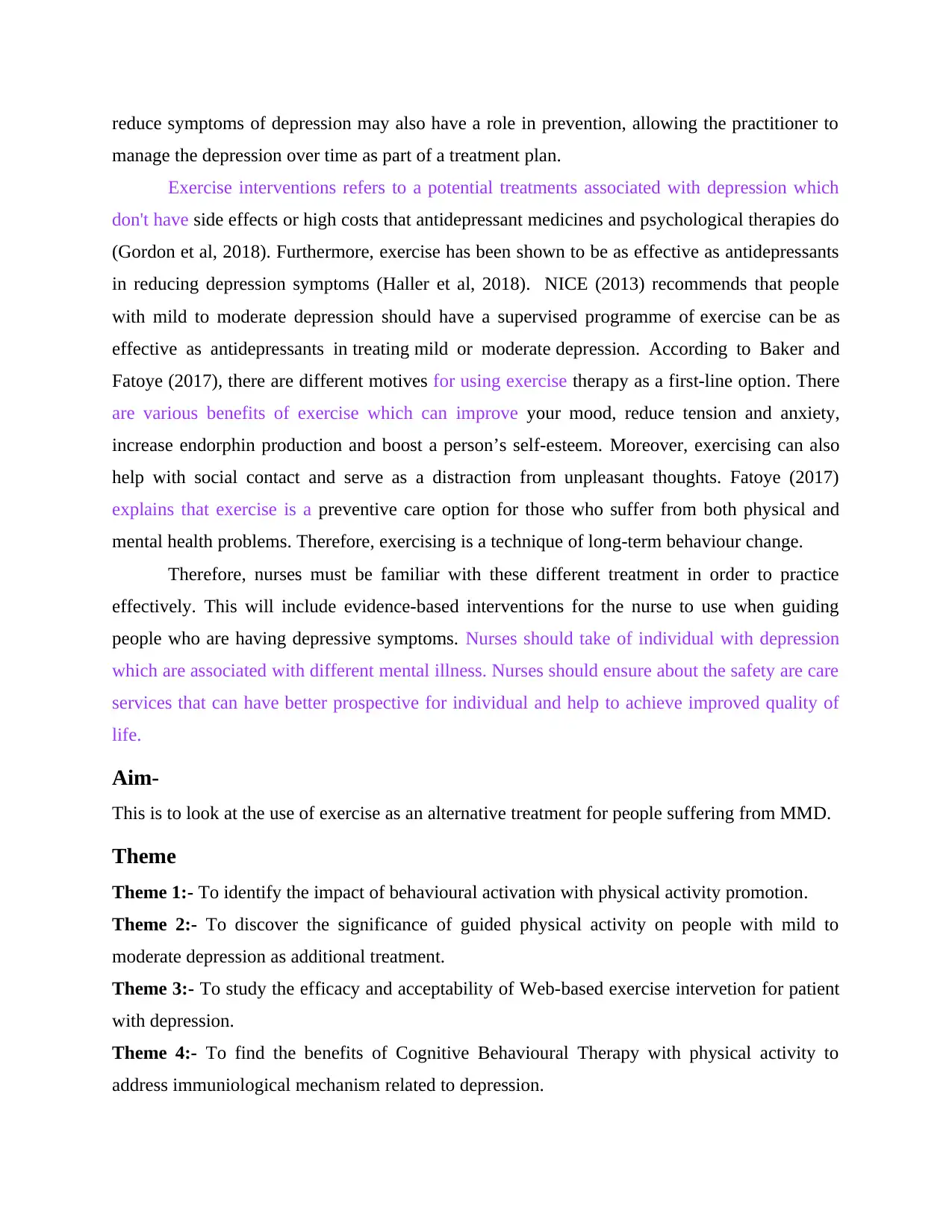
reduce symptoms of depression may also have a role in prevention, allowing the practitioner to
manage the depression over time as part of a treatment plan.
Exercise interventions refers to a potential treatments associated with depression which
don't have side effects or high costs that antidepressant medicines and psychological therapies do
(Gordon et al, 2018). Furthermore, exercise has been shown to be as effective as antidepressants
in reducing depression symptoms (Haller et al, 2018). NICE (2013) recommends that people
with mild to moderate depression should have a supervised programme of exercise can be as
effective as antidepressants in treating mild or moderate depression. According to Baker and
Fatoye (2017), there are different motives for using exercise therapy as a first-line option. There
are various benefits of exercise which can improve your mood, reduce tension and anxiety,
increase endorphin production and boost a person’s self-esteem. Moreover, exercising can also
help with social contact and serve as a distraction from unpleasant thoughts. Fatoye (2017)
explains that exercise is a preventive care option for those who suffer from both physical and
mental health problems. Therefore, exercising is a technique of long-term behaviour change.
Therefore, nurses must be familiar with these different treatment in order to practice
effectively. This will include evidence-based interventions for the nurse to use when guiding
people who are having depressive symptoms. Nurses should take of individual with depression
which are associated with different mental illness. Nurses should ensure about the safety are care
services that can have better prospective for individual and help to achieve improved quality of
life.
Aim-
This is to look at the use of exercise as an alternative treatment for people suffering from MMD.
Theme
Theme 1:- To identify the impact of behavioural activation with physical activity promotion.
Theme 2:- To discover the significance of guided physical activity on people with mild to
moderate depression as additional treatment.
Theme 3:- To study the efficacy and acceptability of Web-based exercise intervetion for patient
with depression.
Theme 4:- To find the benefits of Cognitive Behavioural Therapy with physical activity to
address immuniological mechanism related to depression.
manage the depression over time as part of a treatment plan.
Exercise interventions refers to a potential treatments associated with depression which
don't have side effects or high costs that antidepressant medicines and psychological therapies do
(Gordon et al, 2018). Furthermore, exercise has been shown to be as effective as antidepressants
in reducing depression symptoms (Haller et al, 2018). NICE (2013) recommends that people
with mild to moderate depression should have a supervised programme of exercise can be as
effective as antidepressants in treating mild or moderate depression. According to Baker and
Fatoye (2017), there are different motives for using exercise therapy as a first-line option. There
are various benefits of exercise which can improve your mood, reduce tension and anxiety,
increase endorphin production and boost a person’s self-esteem. Moreover, exercising can also
help with social contact and serve as a distraction from unpleasant thoughts. Fatoye (2017)
explains that exercise is a preventive care option for those who suffer from both physical and
mental health problems. Therefore, exercising is a technique of long-term behaviour change.
Therefore, nurses must be familiar with these different treatment in order to practice
effectively. This will include evidence-based interventions for the nurse to use when guiding
people who are having depressive symptoms. Nurses should take of individual with depression
which are associated with different mental illness. Nurses should ensure about the safety are care
services that can have better prospective for individual and help to achieve improved quality of
life.
Aim-
This is to look at the use of exercise as an alternative treatment for people suffering from MMD.
Theme
Theme 1:- To identify the impact of behavioural activation with physical activity promotion.
Theme 2:- To discover the significance of guided physical activity on people with mild to
moderate depression as additional treatment.
Theme 3:- To study the efficacy and acceptability of Web-based exercise intervetion for patient
with depression.
Theme 4:- To find the benefits of Cognitive Behavioural Therapy with physical activity to
address immuniological mechanism related to depression.
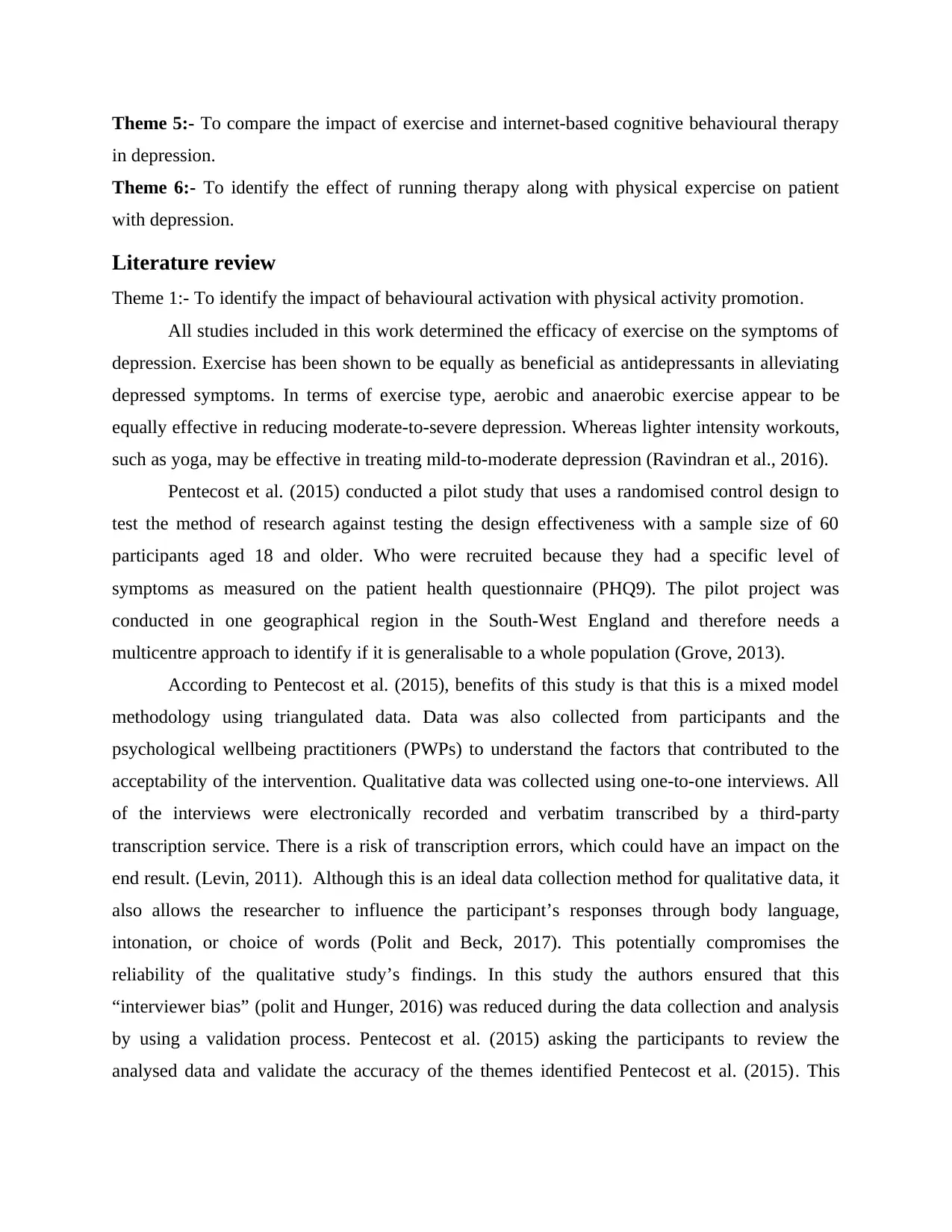
Theme 5:- To compare the impact of exercise and internet-based cognitive behavioural therapy
in depression.
Theme 6:- To identify the effect of running therapy along with physical expercise on patient
with depression.
Literature review
Theme 1:- To identify the impact of behavioural activation with physical activity promotion.
All studies included in this work determined the efficacy of exercise on the symptoms of
depression. Exercise has been shown to be equally as beneficial as antidepressants in alleviating
depressed symptoms. In terms of exercise type, aerobic and anaerobic exercise appear to be
equally effective in reducing moderate-to-severe depression. Whereas lighter intensity workouts,
such as yoga, may be effective in treating mild-to-moderate depression (Ravindran et al., 2016).
Pentecost et al. (2015) conducted a pilot study that uses a randomised control design to
test the method of research against testing the design effectiveness with a sample size of 60
participants aged 18 and older. Who were recruited because they had a specific level of
symptoms as measured on the patient health questionnaire (PHQ9). The pilot project was
conducted in one geographical region in the South-West England and therefore needs a
multicentre approach to identify if it is generalisable to a whole population (Grove, 2013).
According to Pentecost et al. (2015), benefits of this study is that this is a mixed model
methodology using triangulated data. Data was also collected from participants and the
psychological wellbeing practitioners (PWPs) to understand the factors that contributed to the
acceptability of the intervention. Qualitative data was collected using one-to-one interviews. All
of the interviews were electronically recorded and verbatim transcribed by a third-party
transcription service. There is a risk of transcription errors, which could have an impact on the
end result. (Levin, 2011). Although this is an ideal data collection method for qualitative data, it
also allows the researcher to influence the participant’s responses through body language,
intonation, or choice of words (Polit and Beck, 2017). This potentially compromises the
reliability of the qualitative study’s findings. In this study the authors ensured that this
“interviewer bias” (polit and Hunger, 2016) was reduced during the data collection and analysis
by using a validation process. Pentecost et al. (2015) asking the participants to review the
analysed data and validate the accuracy of the themes identified Pentecost et al. (2015). This
in depression.
Theme 6:- To identify the effect of running therapy along with physical expercise on patient
with depression.
Literature review
Theme 1:- To identify the impact of behavioural activation with physical activity promotion.
All studies included in this work determined the efficacy of exercise on the symptoms of
depression. Exercise has been shown to be equally as beneficial as antidepressants in alleviating
depressed symptoms. In terms of exercise type, aerobic and anaerobic exercise appear to be
equally effective in reducing moderate-to-severe depression. Whereas lighter intensity workouts,
such as yoga, may be effective in treating mild-to-moderate depression (Ravindran et al., 2016).
Pentecost et al. (2015) conducted a pilot study that uses a randomised control design to
test the method of research against testing the design effectiveness with a sample size of 60
participants aged 18 and older. Who were recruited because they had a specific level of
symptoms as measured on the patient health questionnaire (PHQ9). The pilot project was
conducted in one geographical region in the South-West England and therefore needs a
multicentre approach to identify if it is generalisable to a whole population (Grove, 2013).
According to Pentecost et al. (2015), benefits of this study is that this is a mixed model
methodology using triangulated data. Data was also collected from participants and the
psychological wellbeing practitioners (PWPs) to understand the factors that contributed to the
acceptability of the intervention. Qualitative data was collected using one-to-one interviews. All
of the interviews were electronically recorded and verbatim transcribed by a third-party
transcription service. There is a risk of transcription errors, which could have an impact on the
end result. (Levin, 2011). Although this is an ideal data collection method for qualitative data, it
also allows the researcher to influence the participant’s responses through body language,
intonation, or choice of words (Polit and Beck, 2017). This potentially compromises the
reliability of the qualitative study’s findings. In this study the authors ensured that this
“interviewer bias” (polit and Hunger, 2016) was reduced during the data collection and analysis
by using a validation process. Pentecost et al. (2015) asking the participants to review the
analysed data and validate the accuracy of the themes identified Pentecost et al. (2015). This
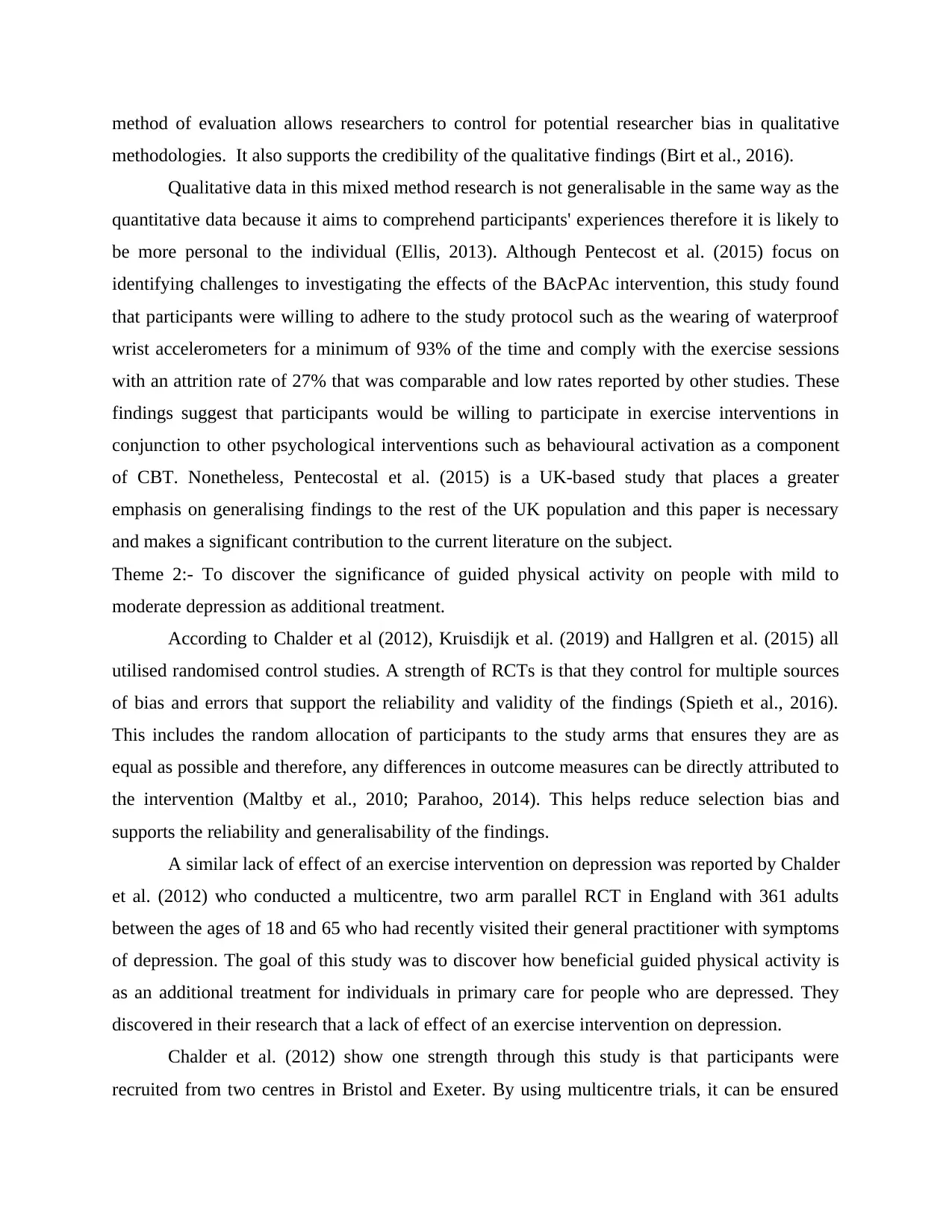
method of evaluation allows researchers to control for potential researcher bias in qualitative
methodologies. It also supports the credibility of the qualitative findings (Birt et al., 2016).
Qualitative data in this mixed method research is not generalisable in the same way as the
quantitative data because it aims to comprehend participants' experiences therefore it is likely to
be more personal to the individual (Ellis, 2013). Although Pentecost et al. (2015) focus on
identifying challenges to investigating the effects of the BAcPAc intervention, this study found
that participants were willing to adhere to the study protocol such as the wearing of waterproof
wrist accelerometers for a minimum of 93% of the time and comply with the exercise sessions
with an attrition rate of 27% that was comparable and low rates reported by other studies. These
findings suggest that participants would be willing to participate in exercise interventions in
conjunction to other psychological interventions such as behavioural activation as a component
of CBT. Nonetheless, Pentecostal et al. (2015) is a UK-based study that places a greater
emphasis on generalising findings to the rest of the UK population and this paper is necessary
and makes a significant contribution to the current literature on the subject.
Theme 2:- To discover the significance of guided physical activity on people with mild to
moderate depression as additional treatment.
According to Chalder et al (2012), Kruisdijk et al. (2019) and Hallgren et al. (2015) all
utilised randomised control studies. A strength of RCTs is that they control for multiple sources
of bias and errors that support the reliability and validity of the findings (Spieth et al., 2016).
This includes the random allocation of participants to the study arms that ensures they are as
equal as possible and therefore, any differences in outcome measures can be directly attributed to
the intervention (Maltby et al., 2010; Parahoo, 2014). This helps reduce selection bias and
supports the reliability and generalisability of the findings.
A similar lack of effect of an exercise intervention on depression was reported by Chalder
et al. (2012) who conducted a multicentre, two arm parallel RCT in England with 361 adults
between the ages of 18 and 65 who had recently visited their general practitioner with symptoms
of depression. The goal of this study was to discover how beneficial guided physical activity is
as an additional treatment for individuals in primary care for people who are depressed. They
discovered in their research that a lack of effect of an exercise intervention on depression.
Chalder et al. (2012) show one strength through this study is that participants were
recruited from two centres in Bristol and Exeter. By using multicentre trials, it can be ensured
methodologies. It also supports the credibility of the qualitative findings (Birt et al., 2016).
Qualitative data in this mixed method research is not generalisable in the same way as the
quantitative data because it aims to comprehend participants' experiences therefore it is likely to
be more personal to the individual (Ellis, 2013). Although Pentecost et al. (2015) focus on
identifying challenges to investigating the effects of the BAcPAc intervention, this study found
that participants were willing to adhere to the study protocol such as the wearing of waterproof
wrist accelerometers for a minimum of 93% of the time and comply with the exercise sessions
with an attrition rate of 27% that was comparable and low rates reported by other studies. These
findings suggest that participants would be willing to participate in exercise interventions in
conjunction to other psychological interventions such as behavioural activation as a component
of CBT. Nonetheless, Pentecostal et al. (2015) is a UK-based study that places a greater
emphasis on generalising findings to the rest of the UK population and this paper is necessary
and makes a significant contribution to the current literature on the subject.
Theme 2:- To discover the significance of guided physical activity on people with mild to
moderate depression as additional treatment.
According to Chalder et al (2012), Kruisdijk et al. (2019) and Hallgren et al. (2015) all
utilised randomised control studies. A strength of RCTs is that they control for multiple sources
of bias and errors that support the reliability and validity of the findings (Spieth et al., 2016).
This includes the random allocation of participants to the study arms that ensures they are as
equal as possible and therefore, any differences in outcome measures can be directly attributed to
the intervention (Maltby et al., 2010; Parahoo, 2014). This helps reduce selection bias and
supports the reliability and generalisability of the findings.
A similar lack of effect of an exercise intervention on depression was reported by Chalder
et al. (2012) who conducted a multicentre, two arm parallel RCT in England with 361 adults
between the ages of 18 and 65 who had recently visited their general practitioner with symptoms
of depression. The goal of this study was to discover how beneficial guided physical activity is
as an additional treatment for individuals in primary care for people who are depressed. They
discovered in their research that a lack of effect of an exercise intervention on depression.
Chalder et al. (2012) show one strength through this study is that participants were
recruited from two centres in Bristol and Exeter. By using multicentre trials, it can be ensured
Paraphrase This Document
Need a fresh take? Get an instant paraphrase of this document with our AI Paraphraser
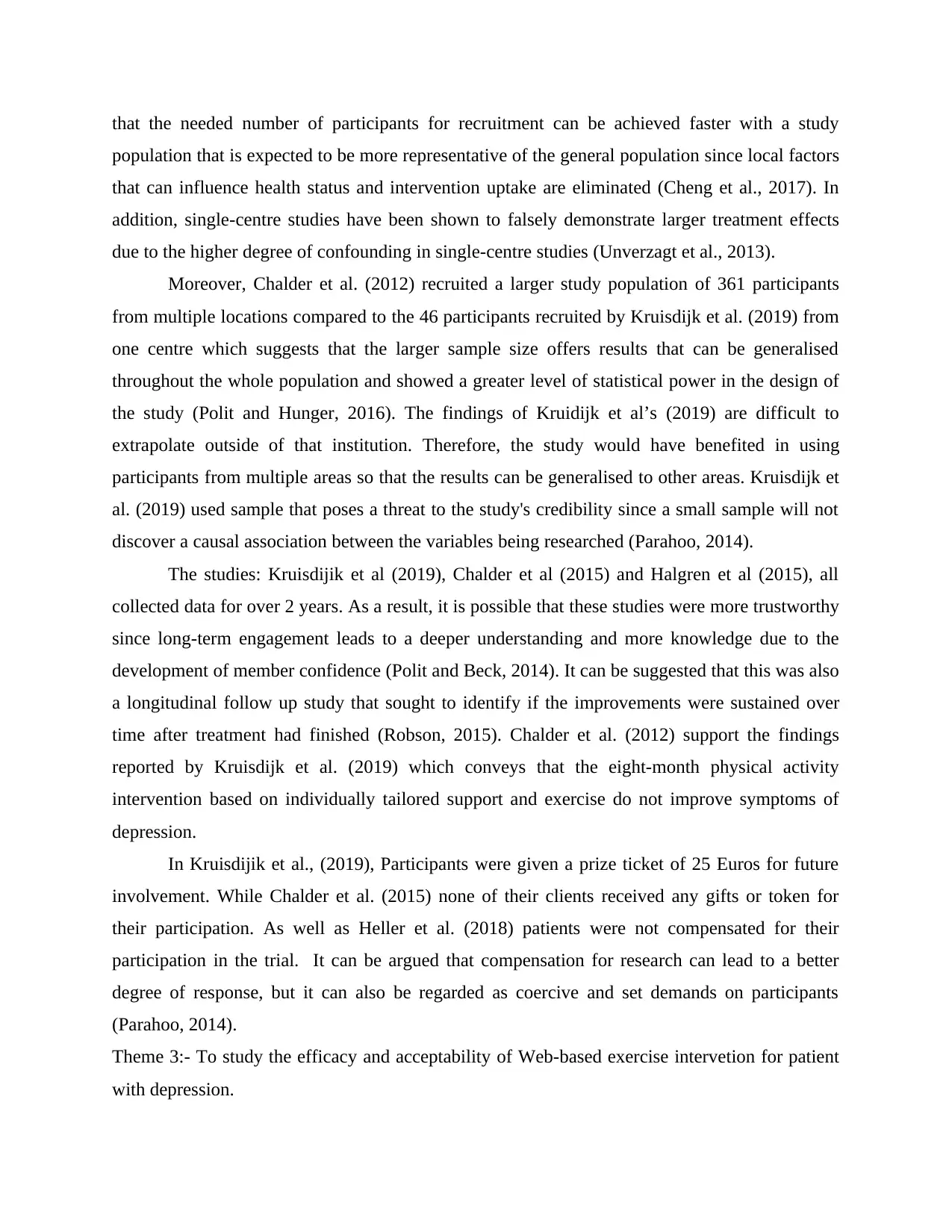
that the needed number of participants for recruitment can be achieved faster with a study
population that is expected to be more representative of the general population since local factors
that can influence health status and intervention uptake are eliminated (Cheng et al., 2017). In
addition, single-centre studies have been shown to falsely demonstrate larger treatment effects
due to the higher degree of confounding in single-centre studies (Unverzagt et al., 2013).
Moreover, Chalder et al. (2012) recruited a larger study population of 361 participants
from multiple locations compared to the 46 participants recruited by Kruisdijk et al. (2019) from
one centre which suggests that the larger sample size offers results that can be generalised
throughout the whole population and showed a greater level of statistical power in the design of
the study (Polit and Hunger, 2016). The findings of Kruidijk et al’s (2019) are difficult to
extrapolate outside of that institution. Therefore, the study would have benefited in using
participants from multiple areas so that the results can be generalised to other areas. Kruisdijk et
al. (2019) used sample that poses a threat to the study's credibility since a small sample will not
discover a causal association between the variables being researched (Parahoo, 2014).
The studies: Kruisdijik et al (2019), Chalder et al (2015) and Halgren et al (2015), all
collected data for over 2 years. As a result, it is possible that these studies were more trustworthy
since long-term engagement leads to a deeper understanding and more knowledge due to the
development of member confidence (Polit and Beck, 2014). It can be suggested that this was also
a longitudinal follow up study that sought to identify if the improvements were sustained over
time after treatment had finished (Robson, 2015). Chalder et al. (2012) support the findings
reported by Kruisdijk et al. (2019) which conveys that the eight-month physical activity
intervention based on individually tailored support and exercise do not improve symptoms of
depression.
In Kruisdijik et al., (2019), Participants were given a prize ticket of 25 Euros for future
involvement. While Chalder et al. (2015) none of their clients received any gifts or token for
their participation. As well as Heller et al. (2018) patients were not compensated for their
participation in the trial. It can be argued that compensation for research can lead to a better
degree of response, but it can also be regarded as coercive and set demands on participants
(Parahoo, 2014).
Theme 3:- To study the efficacy and acceptability of Web-based exercise intervetion for patient
with depression.
population that is expected to be more representative of the general population since local factors
that can influence health status and intervention uptake are eliminated (Cheng et al., 2017). In
addition, single-centre studies have been shown to falsely demonstrate larger treatment effects
due to the higher degree of confounding in single-centre studies (Unverzagt et al., 2013).
Moreover, Chalder et al. (2012) recruited a larger study population of 361 participants
from multiple locations compared to the 46 participants recruited by Kruisdijk et al. (2019) from
one centre which suggests that the larger sample size offers results that can be generalised
throughout the whole population and showed a greater level of statistical power in the design of
the study (Polit and Hunger, 2016). The findings of Kruidijk et al’s (2019) are difficult to
extrapolate outside of that institution. Therefore, the study would have benefited in using
participants from multiple areas so that the results can be generalised to other areas. Kruisdijk et
al. (2019) used sample that poses a threat to the study's credibility since a small sample will not
discover a causal association between the variables being researched (Parahoo, 2014).
The studies: Kruisdijik et al (2019), Chalder et al (2015) and Halgren et al (2015), all
collected data for over 2 years. As a result, it is possible that these studies were more trustworthy
since long-term engagement leads to a deeper understanding and more knowledge due to the
development of member confidence (Polit and Beck, 2014). It can be suggested that this was also
a longitudinal follow up study that sought to identify if the improvements were sustained over
time after treatment had finished (Robson, 2015). Chalder et al. (2012) support the findings
reported by Kruisdijk et al. (2019) which conveys that the eight-month physical activity
intervention based on individually tailored support and exercise do not improve symptoms of
depression.
In Kruisdijik et al., (2019), Participants were given a prize ticket of 25 Euros for future
involvement. While Chalder et al. (2015) none of their clients received any gifts or token for
their participation. As well as Heller et al. (2018) patients were not compensated for their
participation in the trial. It can be argued that compensation for research can lead to a better
degree of response, but it can also be regarded as coercive and set demands on participants
(Parahoo, 2014).
Theme 3:- To study the efficacy and acceptability of Web-based exercise intervetion for patient
with depression.
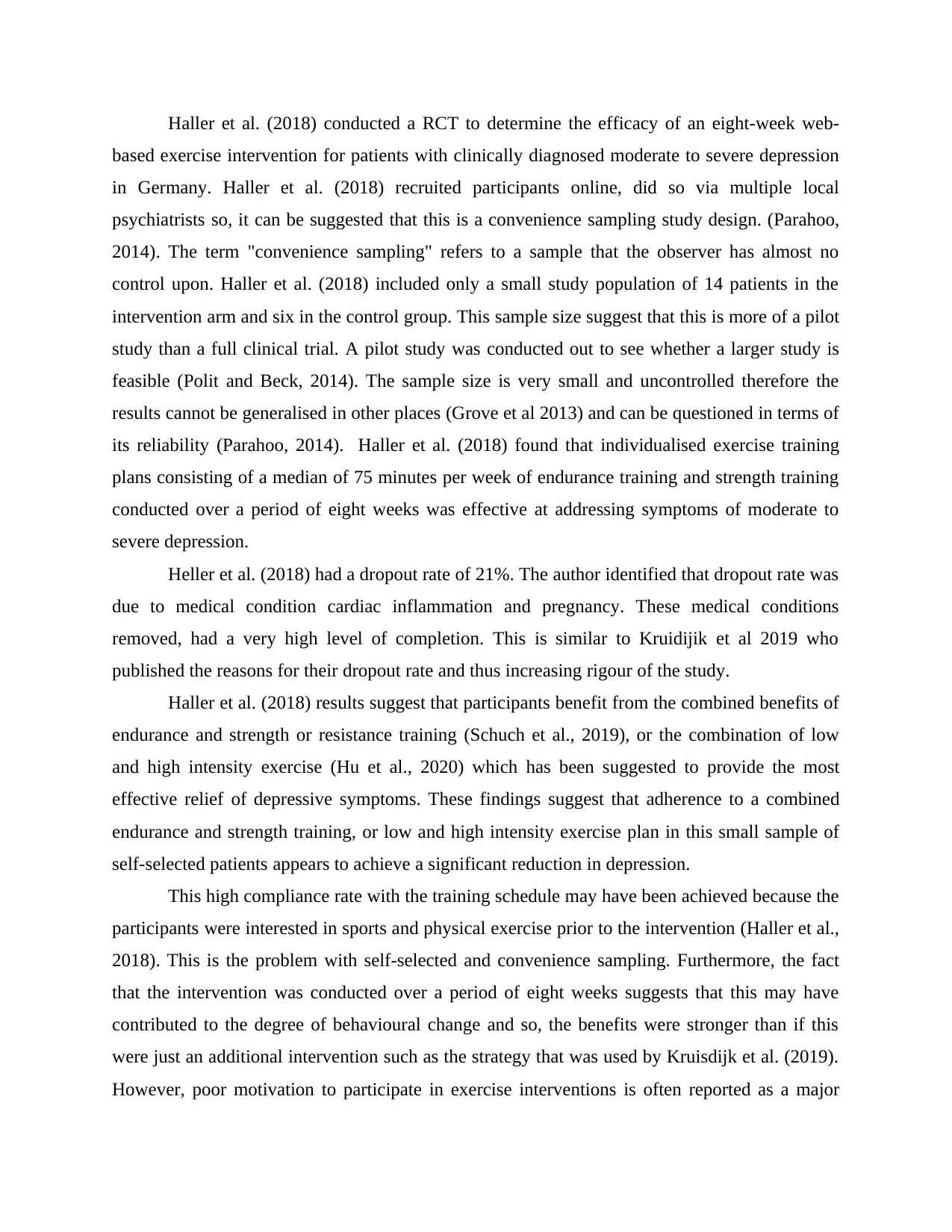
Haller et al. (2018) conducted a RCT to determine the efficacy of an eight-week web-
based exercise intervention for patients with clinically diagnosed moderate to severe depression
in Germany. Haller et al. (2018) recruited participants online, did so via multiple local
psychiatrists so, it can be suggested that this is a convenience sampling study design. (Parahoo,
2014). The term "convenience sampling" refers to a sample that the observer has almost no
control upon. Haller et al. (2018) included only a small study population of 14 patients in the
intervention arm and six in the control group. This sample size suggest that this is more of a pilot
study than a full clinical trial. A pilot study was conducted out to see whether a larger study is
feasible (Polit and Beck, 2014). The sample size is very small and uncontrolled therefore the
results cannot be generalised in other places (Grove et al 2013) and can be questioned in terms of
its reliability (Parahoo, 2014). Haller et al. (2018) found that individualised exercise training
plans consisting of a median of 75 minutes per week of endurance training and strength training
conducted over a period of eight weeks was effective at addressing symptoms of moderate to
severe depression.
Heller et al. (2018) had a dropout rate of 21%. The author identified that dropout rate was
due to medical condition cardiac inflammation and pregnancy. These medical conditions
removed, had a very high level of completion. This is similar to Kruidijik et al 2019 who
published the reasons for their dropout rate and thus increasing rigour of the study.
Haller et al. (2018) results suggest that participants benefit from the combined benefits of
endurance and strength or resistance training (Schuch et al., 2019), or the combination of low
and high intensity exercise (Hu et al., 2020) which has been suggested to provide the most
effective relief of depressive symptoms. These findings suggest that adherence to a combined
endurance and strength training, or low and high intensity exercise plan in this small sample of
self-selected patients appears to achieve a significant reduction in depression.
This high compliance rate with the training schedule may have been achieved because the
participants were interested in sports and physical exercise prior to the intervention (Haller et al.,
2018). This is the problem with self-selected and convenience sampling. Furthermore, the fact
that the intervention was conducted over a period of eight weeks suggests that this may have
contributed to the degree of behavioural change and so, the benefits were stronger than if this
were just an additional intervention such as the strategy that was used by Kruisdijk et al. (2019).
However, poor motivation to participate in exercise interventions is often reported as a major
based exercise intervention for patients with clinically diagnosed moderate to severe depression
in Germany. Haller et al. (2018) recruited participants online, did so via multiple local
psychiatrists so, it can be suggested that this is a convenience sampling study design. (Parahoo,
2014). The term "convenience sampling" refers to a sample that the observer has almost no
control upon. Haller et al. (2018) included only a small study population of 14 patients in the
intervention arm and six in the control group. This sample size suggest that this is more of a pilot
study than a full clinical trial. A pilot study was conducted out to see whether a larger study is
feasible (Polit and Beck, 2014). The sample size is very small and uncontrolled therefore the
results cannot be generalised in other places (Grove et al 2013) and can be questioned in terms of
its reliability (Parahoo, 2014). Haller et al. (2018) found that individualised exercise training
plans consisting of a median of 75 minutes per week of endurance training and strength training
conducted over a period of eight weeks was effective at addressing symptoms of moderate to
severe depression.
Heller et al. (2018) had a dropout rate of 21%. The author identified that dropout rate was
due to medical condition cardiac inflammation and pregnancy. These medical conditions
removed, had a very high level of completion. This is similar to Kruidijik et al 2019 who
published the reasons for their dropout rate and thus increasing rigour of the study.
Haller et al. (2018) results suggest that participants benefit from the combined benefits of
endurance and strength or resistance training (Schuch et al., 2019), or the combination of low
and high intensity exercise (Hu et al., 2020) which has been suggested to provide the most
effective relief of depressive symptoms. These findings suggest that adherence to a combined
endurance and strength training, or low and high intensity exercise plan in this small sample of
self-selected patients appears to achieve a significant reduction in depression.
This high compliance rate with the training schedule may have been achieved because the
participants were interested in sports and physical exercise prior to the intervention (Haller et al.,
2018). This is the problem with self-selected and convenience sampling. Furthermore, the fact
that the intervention was conducted over a period of eight weeks suggests that this may have
contributed to the degree of behavioural change and so, the benefits were stronger than if this
were just an additional intervention such as the strategy that was used by Kruisdijk et al. (2019).
However, poor motivation to participate in exercise interventions is often reported as a major
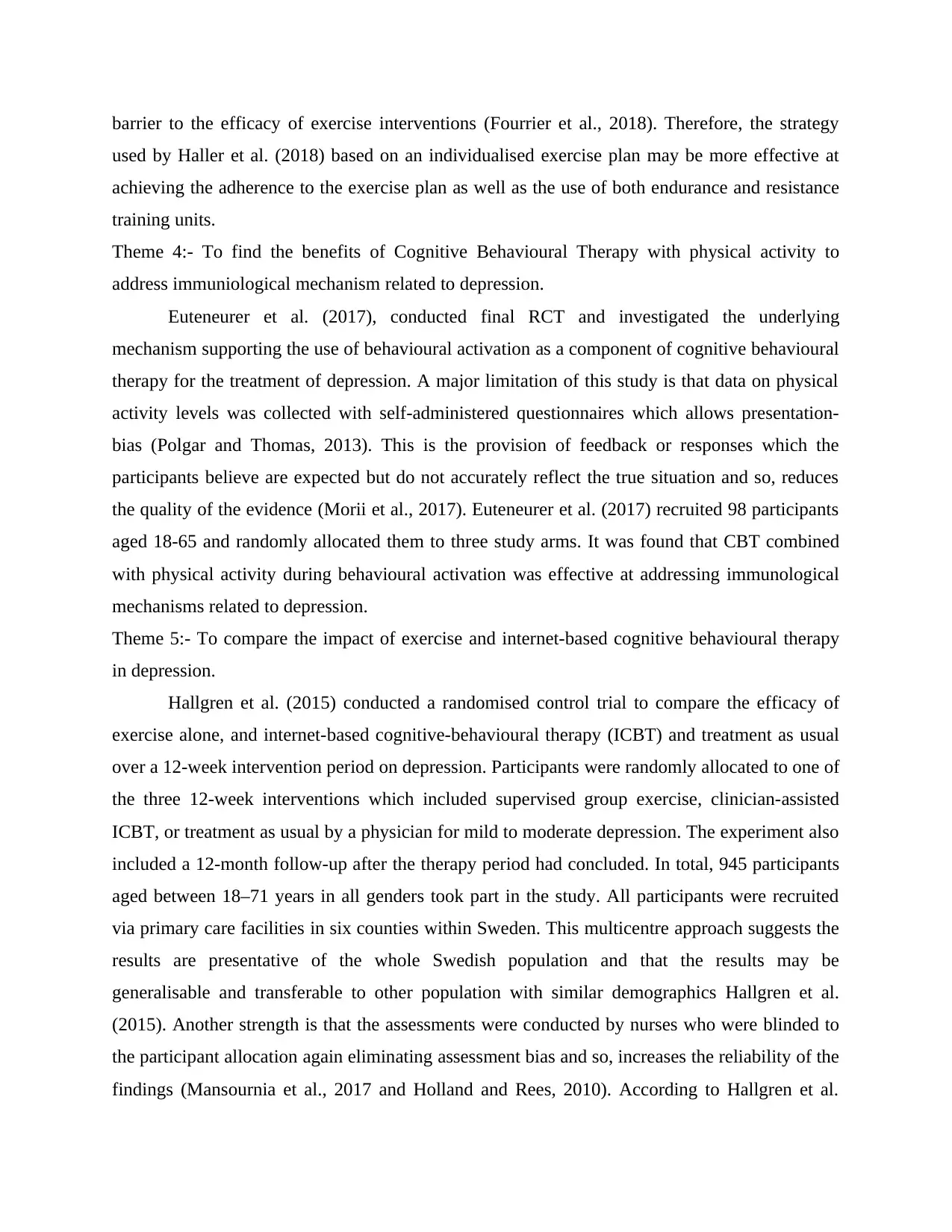
barrier to the efficacy of exercise interventions (Fourrier et al., 2018). Therefore, the strategy
used by Haller et al. (2018) based on an individualised exercise plan may be more effective at
achieving the adherence to the exercise plan as well as the use of both endurance and resistance
training units.
Theme 4:- To find the benefits of Cognitive Behavioural Therapy with physical activity to
address immuniological mechanism related to depression.
Euteneurer et al. (2017), conducted final RCT and investigated the underlying
mechanism supporting the use of behavioural activation as a component of cognitive behavioural
therapy for the treatment of depression. A major limitation of this study is that data on physical
activity levels was collected with self-administered questionnaires which allows presentation-
bias (Polgar and Thomas, 2013). This is the provision of feedback or responses which the
participants believe are expected but do not accurately reflect the true situation and so, reduces
the quality of the evidence (Morii et al., 2017). Euteneurer et al. (2017) recruited 98 participants
aged 18-65 and randomly allocated them to three study arms. It was found that CBT combined
with physical activity during behavioural activation was effective at addressing immunological
mechanisms related to depression.
Theme 5:- To compare the impact of exercise and internet-based cognitive behavioural therapy
in depression.
Hallgren et al. (2015) conducted a randomised control trial to compare the efficacy of
exercise alone, and internet-based cognitive-behavioural therapy (ICBT) and treatment as usual
over a 12-week intervention period on depression. Participants were randomly allocated to one of
the three 12-week interventions which included supervised group exercise, clinician-assisted
ICBT, or treatment as usual by a physician for mild to moderate depression. The experiment also
included a 12-month follow-up after the therapy period had concluded. In total, 945 participants
aged between 18–71 years in all genders took part in the study. All participants were recruited
via primary care facilities in six counties within Sweden. This multicentre approach suggests the
results are presentative of the whole Swedish population and that the results may be
generalisable and transferable to other population with similar demographics Hallgren et al.
(2015). Another strength is that the assessments were conducted by nurses who were blinded to
the participant allocation again eliminating assessment bias and so, increases the reliability of the
findings (Mansournia et al., 2017 and Holland and Rees, 2010). According to Hallgren et al.
used by Haller et al. (2018) based on an individualised exercise plan may be more effective at
achieving the adherence to the exercise plan as well as the use of both endurance and resistance
training units.
Theme 4:- To find the benefits of Cognitive Behavioural Therapy with physical activity to
address immuniological mechanism related to depression.
Euteneurer et al. (2017), conducted final RCT and investigated the underlying
mechanism supporting the use of behavioural activation as a component of cognitive behavioural
therapy for the treatment of depression. A major limitation of this study is that data on physical
activity levels was collected with self-administered questionnaires which allows presentation-
bias (Polgar and Thomas, 2013). This is the provision of feedback or responses which the
participants believe are expected but do not accurately reflect the true situation and so, reduces
the quality of the evidence (Morii et al., 2017). Euteneurer et al. (2017) recruited 98 participants
aged 18-65 and randomly allocated them to three study arms. It was found that CBT combined
with physical activity during behavioural activation was effective at addressing immunological
mechanisms related to depression.
Theme 5:- To compare the impact of exercise and internet-based cognitive behavioural therapy
in depression.
Hallgren et al. (2015) conducted a randomised control trial to compare the efficacy of
exercise alone, and internet-based cognitive-behavioural therapy (ICBT) and treatment as usual
over a 12-week intervention period on depression. Participants were randomly allocated to one of
the three 12-week interventions which included supervised group exercise, clinician-assisted
ICBT, or treatment as usual by a physician for mild to moderate depression. The experiment also
included a 12-month follow-up after the therapy period had concluded. In total, 945 participants
aged between 18–71 years in all genders took part in the study. All participants were recruited
via primary care facilities in six counties within Sweden. This multicentre approach suggests the
results are presentative of the whole Swedish population and that the results may be
generalisable and transferable to other population with similar demographics Hallgren et al.
(2015). Another strength is that the assessments were conducted by nurses who were blinded to
the participant allocation again eliminating assessment bias and so, increases the reliability of the
findings (Mansournia et al., 2017 and Holland and Rees, 2010). According to Hallgren et al.
Secure Best Marks with AI Grader
Need help grading? Try our AI Grader for instant feedback on your assignments.
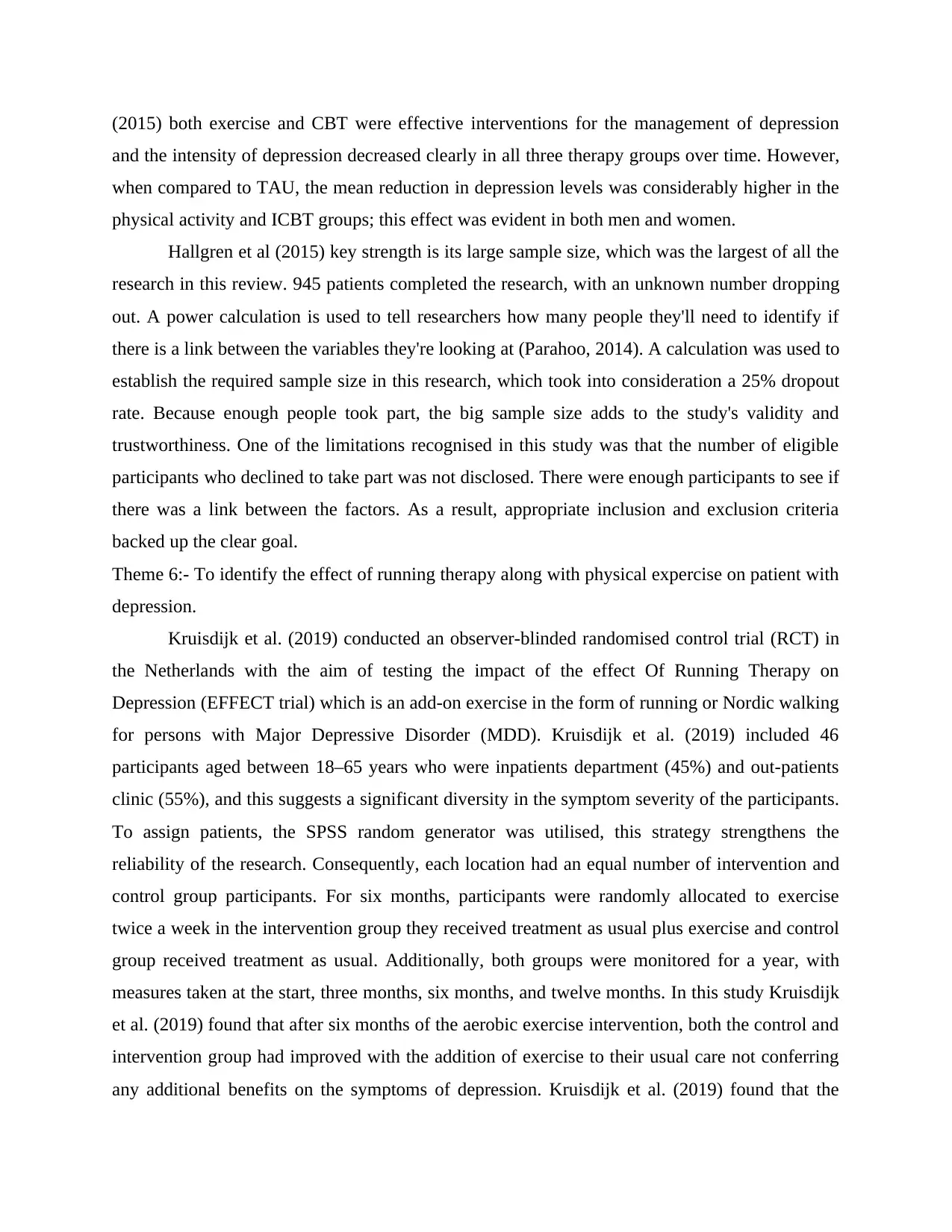
(2015) both exercise and CBT were effective interventions for the management of depression
and the intensity of depression decreased clearly in all three therapy groups over time. However,
when compared to TAU, the mean reduction in depression levels was considerably higher in the
physical activity and ICBT groups; this effect was evident in both men and women.
Hallgren et al (2015) key strength is its large sample size, which was the largest of all the
research in this review. 945 patients completed the research, with an unknown number dropping
out. A power calculation is used to tell researchers how many people they'll need to identify if
there is a link between the variables they're looking at (Parahoo, 2014). A calculation was used to
establish the required sample size in this research, which took into consideration a 25% dropout
rate. Because enough people took part, the big sample size adds to the study's validity and
trustworthiness. One of the limitations recognised in this study was that the number of eligible
participants who declined to take part was not disclosed. There were enough participants to see if
there was a link between the factors. As a result, appropriate inclusion and exclusion criteria
backed up the clear goal.
Theme 6:- To identify the effect of running therapy along with physical expercise on patient with
depression.
Kruisdijk et al. (2019) conducted an observer-blinded randomised control trial (RCT) in
the Netherlands with the aim of testing the impact of the effect Of Running Therapy on
Depression (EFFECT trial) which is an add-on exercise in the form of running or Nordic walking
for persons with Major Depressive Disorder (MDD). Kruisdijk et al. (2019) included 46
participants aged between 18–65 years who were inpatients department (45%) and out-patients
clinic (55%), and this suggests a significant diversity in the symptom severity of the participants.
To assign patients, the SPSS random generator was utilised, this strategy strengthens the
reliability of the research. Consequently, each location had an equal number of intervention and
control group participants. For six months, participants were randomly allocated to exercise
twice a week in the intervention group they received treatment as usual plus exercise and control
group received treatment as usual. Additionally, both groups were monitored for a year, with
measures taken at the start, three months, six months, and twelve months. In this study Kruisdijk
et al. (2019) found that after six months of the aerobic exercise intervention, both the control and
intervention group had improved with the addition of exercise to their usual care not conferring
any additional benefits on the symptoms of depression. Kruisdijk et al. (2019) found that the
and the intensity of depression decreased clearly in all three therapy groups over time. However,
when compared to TAU, the mean reduction in depression levels was considerably higher in the
physical activity and ICBT groups; this effect was evident in both men and women.
Hallgren et al (2015) key strength is its large sample size, which was the largest of all the
research in this review. 945 patients completed the research, with an unknown number dropping
out. A power calculation is used to tell researchers how many people they'll need to identify if
there is a link between the variables they're looking at (Parahoo, 2014). A calculation was used to
establish the required sample size in this research, which took into consideration a 25% dropout
rate. Because enough people took part, the big sample size adds to the study's validity and
trustworthiness. One of the limitations recognised in this study was that the number of eligible
participants who declined to take part was not disclosed. There were enough participants to see if
there was a link between the factors. As a result, appropriate inclusion and exclusion criteria
backed up the clear goal.
Theme 6:- To identify the effect of running therapy along with physical expercise on patient with
depression.
Kruisdijk et al. (2019) conducted an observer-blinded randomised control trial (RCT) in
the Netherlands with the aim of testing the impact of the effect Of Running Therapy on
Depression (EFFECT trial) which is an add-on exercise in the form of running or Nordic walking
for persons with Major Depressive Disorder (MDD). Kruisdijk et al. (2019) included 46
participants aged between 18–65 years who were inpatients department (45%) and out-patients
clinic (55%), and this suggests a significant diversity in the symptom severity of the participants.
To assign patients, the SPSS random generator was utilised, this strategy strengthens the
reliability of the research. Consequently, each location had an equal number of intervention and
control group participants. For six months, participants were randomly allocated to exercise
twice a week in the intervention group they received treatment as usual plus exercise and control
group received treatment as usual. Additionally, both groups were monitored for a year, with
measures taken at the start, three months, six months, and twelve months. In this study Kruisdijk
et al. (2019) found that after six months of the aerobic exercise intervention, both the control and
intervention group had improved with the addition of exercise to their usual care not conferring
any additional benefits on the symptoms of depression. Kruisdijk et al. (2019) found that the
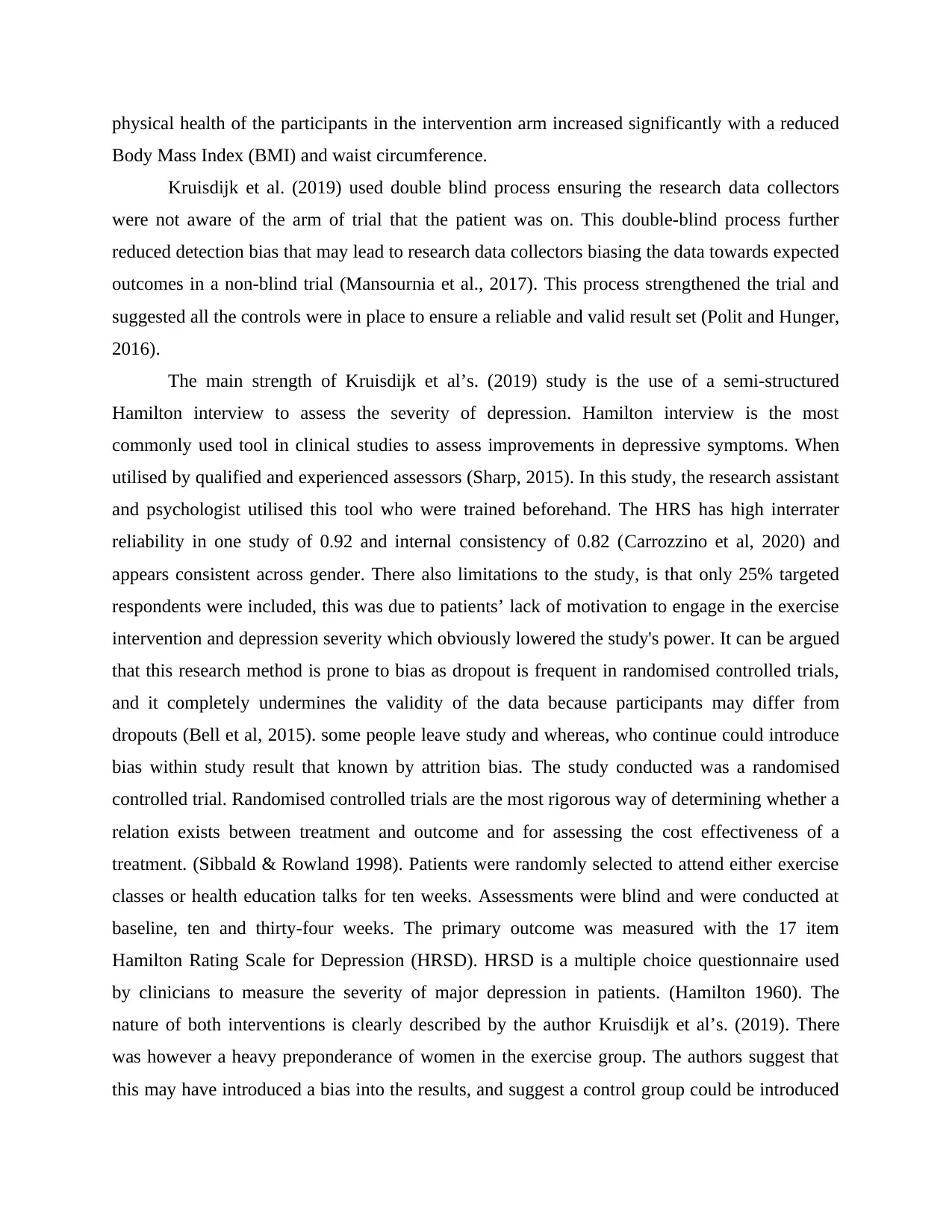
physical health of the participants in the intervention arm increased significantly with a reduced
Body Mass Index (BMI) and waist circumference.
Kruisdijk et al. (2019) used double blind process ensuring the research data collectors
were not aware of the arm of trial that the patient was on. This double-blind process further
reduced detection bias that may lead to research data collectors biasing the data towards expected
outcomes in a non-blind trial (Mansournia et al., 2017). This process strengthened the trial and
suggested all the controls were in place to ensure a reliable and valid result set (Polit and Hunger,
2016).
The main strength of Kruisdijk et al’s. (2019) study is the use of a semi-structured
Hamilton interview to assess the severity of depression. Hamilton interview is the most
commonly used tool in clinical studies to assess improvements in depressive symptoms. When
utilised by qualified and experienced assessors (Sharp, 2015). In this study, the research assistant
and psychologist utilised this tool who were trained beforehand. The HRS has high interrater
reliability in one study of 0.92 and internal consistency of 0.82 (Carrozzino et al, 2020) and
appears consistent across gender. There also limitations to the study, is that only 25% targeted
respondents were included, this was due to patients’ lack of motivation to engage in the exercise
intervention and depression severity which obviously lowered the study's power. It can be argued
that this research method is prone to bias as dropout is frequent in randomised controlled trials,
and it completely undermines the validity of the data because participants may differ from
dropouts (Bell et al, 2015). some people leave study and whereas, who continue could introduce
bias within study result that known by attrition bias. The study conducted was a randomised
controlled trial. Randomised controlled trials are the most rigorous way of determining whether a
relation exists between treatment and outcome and for assessing the cost effectiveness of a
treatment. (Sibbald & Rowland 1998). Patients were randomly selected to attend either exercise
classes or health education talks for ten weeks. Assessments were blind and were conducted at
baseline, ten and thirty-four weeks. The primary outcome was measured with the 17 item
Hamilton Rating Scale for Depression (HRSD). HRSD is a multiple choice questionnaire used
by clinicians to measure the severity of major depression in patients. (Hamilton 1960). The
nature of both interventions is clearly described by the author Kruisdijk et al’s. (2019). There
was however a heavy preponderance of women in the exercise group. The authors suggest that
this may have introduced a bias into the results, and suggest a control group could be introduced
Body Mass Index (BMI) and waist circumference.
Kruisdijk et al. (2019) used double blind process ensuring the research data collectors
were not aware of the arm of trial that the patient was on. This double-blind process further
reduced detection bias that may lead to research data collectors biasing the data towards expected
outcomes in a non-blind trial (Mansournia et al., 2017). This process strengthened the trial and
suggested all the controls were in place to ensure a reliable and valid result set (Polit and Hunger,
2016).
The main strength of Kruisdijk et al’s. (2019) study is the use of a semi-structured
Hamilton interview to assess the severity of depression. Hamilton interview is the most
commonly used tool in clinical studies to assess improvements in depressive symptoms. When
utilised by qualified and experienced assessors (Sharp, 2015). In this study, the research assistant
and psychologist utilised this tool who were trained beforehand. The HRS has high interrater
reliability in one study of 0.92 and internal consistency of 0.82 (Carrozzino et al, 2020) and
appears consistent across gender. There also limitations to the study, is that only 25% targeted
respondents were included, this was due to patients’ lack of motivation to engage in the exercise
intervention and depression severity which obviously lowered the study's power. It can be argued
that this research method is prone to bias as dropout is frequent in randomised controlled trials,
and it completely undermines the validity of the data because participants may differ from
dropouts (Bell et al, 2015). some people leave study and whereas, who continue could introduce
bias within study result that known by attrition bias. The study conducted was a randomised
controlled trial. Randomised controlled trials are the most rigorous way of determining whether a
relation exists between treatment and outcome and for assessing the cost effectiveness of a
treatment. (Sibbald & Rowland 1998). Patients were randomly selected to attend either exercise
classes or health education talks for ten weeks. Assessments were blind and were conducted at
baseline, ten and thirty-four weeks. The primary outcome was measured with the 17 item
Hamilton Rating Scale for Depression (HRSD). HRSD is a multiple choice questionnaire used
by clinicians to measure the severity of major depression in patients. (Hamilton 1960). The
nature of both interventions is clearly described by the author Kruisdijk et al’s. (2019). There
was however a heavy preponderance of women in the exercise group. The authors suggest that
this may have introduced a bias into the results, and suggest a control group could be introduced

in the future without either intervention. The outcomes for both groups were measured in the
same way by the proportion of participants achieving a greater than thirty percent reduction in
HRSD score from baseline. There are some limitations to this study however. The sample size
was small and thus the statistical power was weak. The diagnosis of minor depression was based
on self diagnosis rather than clinical interview. It was also not stated in the report what the usual
care was.
same way by the proportion of participants achieving a greater than thirty percent reduction in
HRSD score from baseline. There are some limitations to this study however. The sample size
was small and thus the statistical power was weak. The diagnosis of minor depression was based
on self diagnosis rather than clinical interview. It was also not stated in the report what the usual
care was.
Paraphrase This Document
Need a fresh take? Get an instant paraphrase of this document with our AI Paraphraser
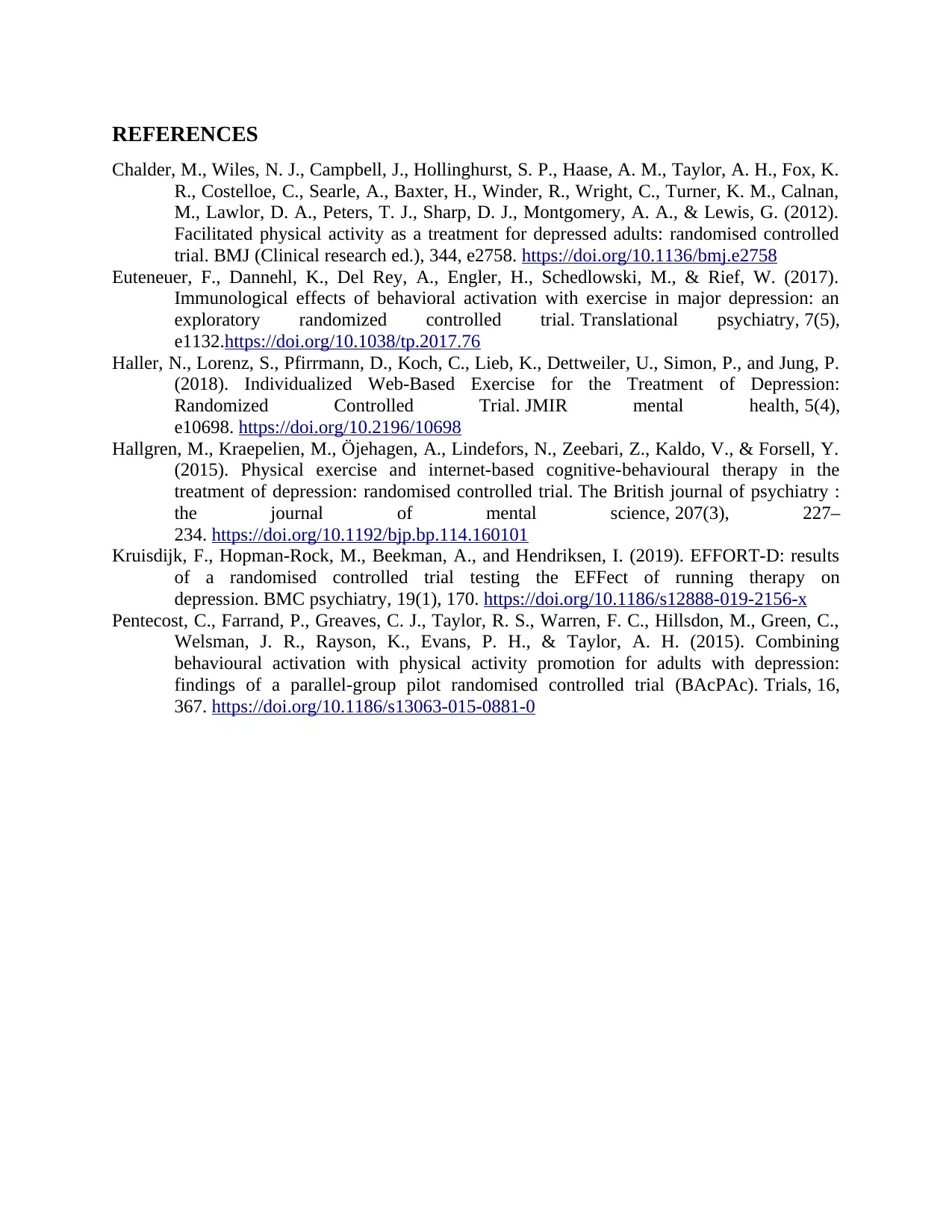
REFERENCES
Chalder, M., Wiles, N. J., Campbell, J., Hollinghurst, S. P., Haase, A. M., Taylor, A. H., Fox, K.
R., Costelloe, C., Searle, A., Baxter, H., Winder, R., Wright, C., Turner, K. M., Calnan,
M., Lawlor, D. A., Peters, T. J., Sharp, D. J., Montgomery, A. A., & Lewis, G. (2012).
Facilitated physical activity as a treatment for depressed adults: randomised controlled
trial. BMJ (Clinical research ed.), 344, e2758. https://doi.org/10.1136/bmj.e2758
Euteneuer, F., Dannehl, K., Del Rey, A., Engler, H., Schedlowski, M., & Rief, W. (2017).
Immunological effects of behavioral activation with exercise in major depression: an
exploratory randomized controlled trial. Translational psychiatry, 7(5),
e1132.https://doi.org/10.1038/tp.2017.76
Haller, N., Lorenz, S., Pfirrmann, D., Koch, C., Lieb, K., Dettweiler, U., Simon, P., and Jung, P.
(2018). Individualized Web-Based Exercise for the Treatment of Depression:
Randomized Controlled Trial. JMIR mental health, 5(4),
e10698. https://doi.org/10.2196/10698
Hallgren, M., Kraepelien, M., Öjehagen, A., Lindefors, N., Zeebari, Z., Kaldo, V., & Forsell, Y.
(2015). Physical exercise and internet-based cognitive-behavioural therapy in the
treatment of depression: randomised controlled trial. The British journal of psychiatry :
the journal of mental science, 207(3), 227–
234. https://doi.org/10.1192/bjp.bp.114.160101
Kruisdijk, F., Hopman-Rock, M., Beekman, A., and Hendriksen, I. (2019). EFFORT-D: results
of a randomised controlled trial testing the EFFect of running therapy on
depression. BMC psychiatry, 19(1), 170. https://doi.org/10.1186/s12888-019-2156-x
Pentecost, C., Farrand, P., Greaves, C. J., Taylor, R. S., Warren, F. C., Hillsdon, M., Green, C.,
Welsman, J. R., Rayson, K., Evans, P. H., & Taylor, A. H. (2015). Combining
behavioural activation with physical activity promotion for adults with depression:
findings of a parallel-group pilot randomised controlled trial (BAcPAc). Trials, 16,
367. https://doi.org/10.1186/s13063-015-0881-0
Chalder, M., Wiles, N. J., Campbell, J., Hollinghurst, S. P., Haase, A. M., Taylor, A. H., Fox, K.
R., Costelloe, C., Searle, A., Baxter, H., Winder, R., Wright, C., Turner, K. M., Calnan,
M., Lawlor, D. A., Peters, T. J., Sharp, D. J., Montgomery, A. A., & Lewis, G. (2012).
Facilitated physical activity as a treatment for depressed adults: randomised controlled
trial. BMJ (Clinical research ed.), 344, e2758. https://doi.org/10.1136/bmj.e2758
Euteneuer, F., Dannehl, K., Del Rey, A., Engler, H., Schedlowski, M., & Rief, W. (2017).
Immunological effects of behavioral activation with exercise in major depression: an
exploratory randomized controlled trial. Translational psychiatry, 7(5),
e1132.https://doi.org/10.1038/tp.2017.76
Haller, N., Lorenz, S., Pfirrmann, D., Koch, C., Lieb, K., Dettweiler, U., Simon, P., and Jung, P.
(2018). Individualized Web-Based Exercise for the Treatment of Depression:
Randomized Controlled Trial. JMIR mental health, 5(4),
e10698. https://doi.org/10.2196/10698
Hallgren, M., Kraepelien, M., Öjehagen, A., Lindefors, N., Zeebari, Z., Kaldo, V., & Forsell, Y.
(2015). Physical exercise and internet-based cognitive-behavioural therapy in the
treatment of depression: randomised controlled trial. The British journal of psychiatry :
the journal of mental science, 207(3), 227–
234. https://doi.org/10.1192/bjp.bp.114.160101
Kruisdijk, F., Hopman-Rock, M., Beekman, A., and Hendriksen, I. (2019). EFFORT-D: results
of a randomised controlled trial testing the EFFect of running therapy on
depression. BMC psychiatry, 19(1), 170. https://doi.org/10.1186/s12888-019-2156-x
Pentecost, C., Farrand, P., Greaves, C. J., Taylor, R. S., Warren, F. C., Hillsdon, M., Green, C.,
Welsman, J. R., Rayson, K., Evans, P. H., & Taylor, A. H. (2015). Combining
behavioural activation with physical activity promotion for adults with depression:
findings of a parallel-group pilot randomised controlled trial (BAcPAc). Trials, 16,
367. https://doi.org/10.1186/s13063-015-0881-0
1 out of 14
Related Documents
Your All-in-One AI-Powered Toolkit for Academic Success.
+13062052269
info@desklib.com
Available 24*7 on WhatsApp / Email
![[object Object]](/_next/static/media/star-bottom.7253800d.svg)
Unlock your academic potential
© 2024 | Zucol Services PVT LTD | All rights reserved.





